The Bras du Chapitre © Annabel Simms In the Middle Ages the islands were owned by the canons of Notre-Dame de Paris, who leased them to the local population to help maintain the weeping willows and prevent the fertile soil from being washed away by the Marne. The neglected state of the land after the war made it a cheap and attractive proposition to the disaffected 1968 generation looking for a rural alternative to the new town being created by the planners in Créteil.
Villa, Allée Centrale, Ile Brise-Pain © Annabel Simms In 1978 these new residents formed an association to preserve the islands from urban development and succeeded in getting the 20-hectare site listed in 1982. The islands have scarcely changed since then. It remains to be seen whether the new métro station on the Créteil side being constructed as part of the Grand Paris project will change this state of affairs, but I would put my money on the tried and tested resolution of the residents to keep their paradise intact. 6 km walk to the islands, returning from St Maur-Créteil
From the métro station at Créteil-Université take exit no. 2 for the Route de Choisy, then the right-hand path marked by a red and white GR sign. When the path forks again, take the left-hand fork and continue slightly uphill along the main road, the Rue des Mèches (D86) until you come to a café-tabac, L’Interlude. Take the pedestrian crossing here over the Rue des Mèches and continue uphill. You will pass the pretty little Parc Dupeyroux surrounding an old mansion, whose formal grounds were transformed by its English owner in the 19th century into a parc à l’anglaise. Further on you will pass the imposing gates to the mansion, which is now the residence of the Prefect of the Val de Marne.
If you are looking for a day out in the country you can find it, astonishingly enough, at the end of the line 8 métro in Créteil. Weeping willows frame four small islands linked by footbridges, forming a quiet backwater of the River Marne. Little known to the residents of Créteil or St Maur across the river, let alone Parisians or foreigners, the islands are a hidden pocket of countryside at the edge of the city, home to wildflowers, swans, ducks, herons and the beaver-like coypu, as well as the lucky human residents.
Créteil, characterized by charmless 1960s architecture, is the last place on earth where you would expect to find four islands containing only old houses and villas built in an eclectic mix of styles, hidden by ancient trees and encircled by riverside walks. Apart from a swimming pool, a small park and a restaurant, the islands are exclusively residential. The roads feel like footpaths, with scarcely a car in sight.
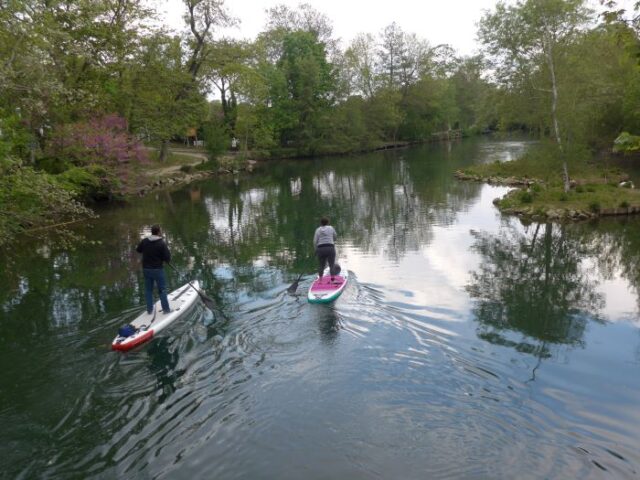
The Bras du Chapitre © Annabel Simms
In the Middle Ages the islands were owned by the canons of Notre-Dame de Paris, who leased them to the local population to help maintain the weeping willows and prevent the fertile soil from being washed away by the Marne. The neglected state of the land after the war made it a cheap and attractive proposition to the disaffected 1968 generation looking for a rural alternative to the new town being created by the planners in Créteil.
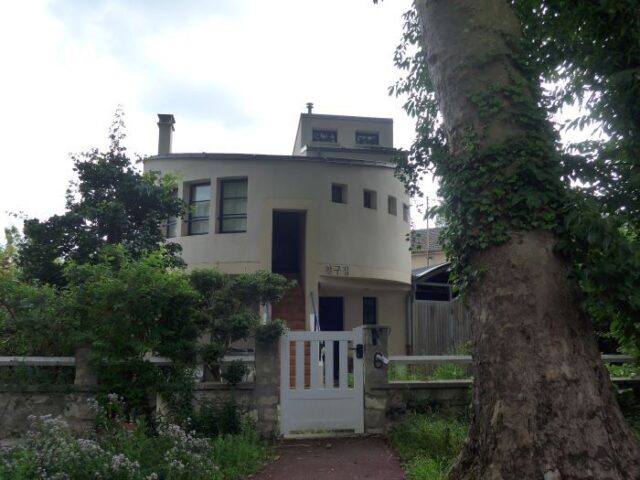
Villa, Allée Centrale, Ile Brise-Pain © Annabel Simms
In 1978 these new residents formed an association to preserve the islands from urban development and succeeded in getting the 20-hectare site listed in 1982. The islands have scarcely changed since then. It remains to be seen whether the new métro station on the Créteil side being constructed as part of the Grand Paris project will change this state of affairs, but I would put my money on the tried and tested resolution of the residents to keep their paradise intact.
6 km walk to the islands, returning from St Maur-Créteil
From the métro station at Créteil-Université take exit no. 2 for the Route de Choisy, then the right-hand path marked by a red and white GR sign. When the path forks again, take the left-hand fork and continue slightly uphill along the main road, the Rue des Mèches (D86) until you come to a café-tabac, L’Interlude. Take the pedestrian crossing here over the Rue des Mèches and continue uphill.
You will pass the pretty little Parc Dupeyroux surrounding an old mansion, whose formal grounds were transformed by its English owner in the 19th century into a parc à l’anglaise. Further on you will pass the imposing gates to the mansion, which is now the residence of the Prefect of the Val de Marne.
Further up the road, opposite the church, you will cross the pedestrianized Rue du Général Leclerc. There is a market here on Thursday and Sunday mornings and it is a good street in which to buy picnic supplies as there are no shops on the islands to which you are headed.
Soon afterwards you will pass Le Jardin des Mérovingiens, a tiny park with some ancient stones poking out of the ground, actually the remains of an eighth-century necropolis.
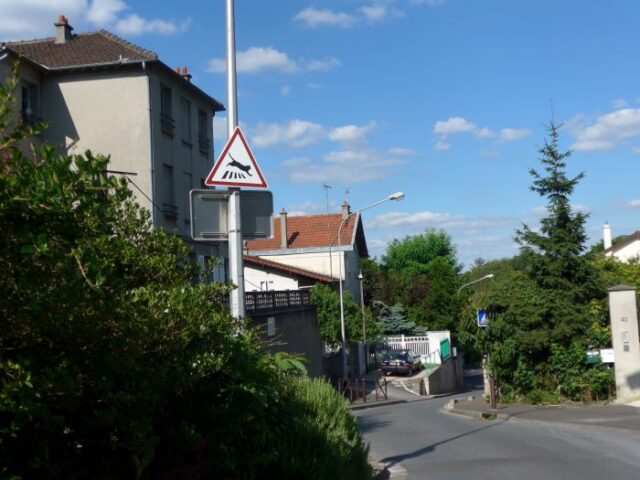
The road to the islands, Rue du Moulin © Annabel Simms
Turn right from the park into the Rue Dr Plichon, continue into the Rue du Moulin, follow it downhill to the end, past a sign warning drivers to watch out for cats, and turn right.
The little footbridge to the islands leading to the Allée des Coucous (Cowslip Lane) is straight in front of you and looks very tempting, but you will take it on the way back.
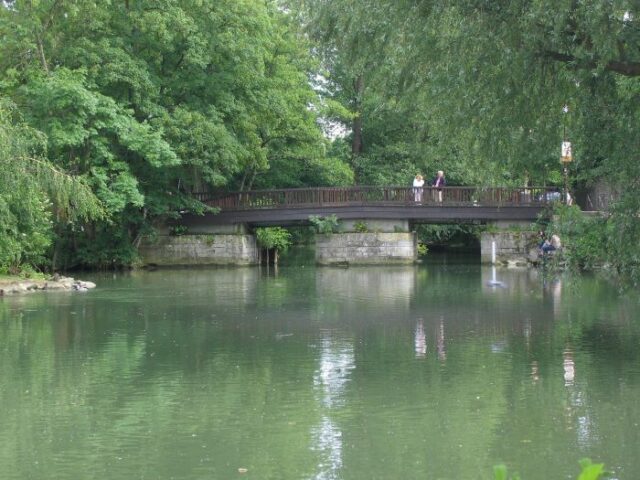
Footbridge to the Allée des Coucous © Annabel Simms
Instead, turn right to follow the quiet riverside path, the Chemin du Bras du Chapitre, which offers endlessly photogenic scenes of green water framed by trees, with glimpses of gardens through the foliage.
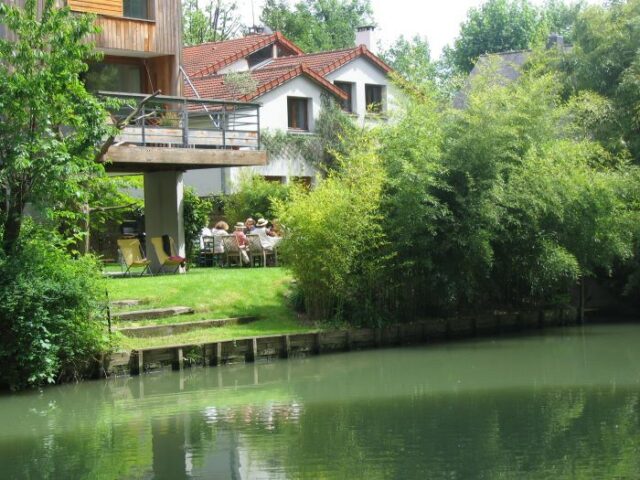
Lunch party overlooking the Bras du Chapitre © Annabel Simms
Just after the little Rue Robert Legeay on your right two signs in French inform you of the history of the next two houses. The first one, a former guinguette, was the headquarters of the local Resistance group between 1943 and 1944, and its chicken-run concealed a radio receiver used to communicate clandestinely with London.
The larger house next door used to be an inn, owned by a M. Bellier, whose bateau lessive (laundry boat) operated on the Bras du Chapitre for 50 years. Victor Hugo may have stayed at the inn as he wrote about the laundry boat in La Lavandière (The Washerwoman), a poem published in 1865. For years the former inn was a reputed restaurant which closed down about 10 years ago, presumably when the owners retired, ending the history of an establishment largely unchanged since Victor Hugo’s day.
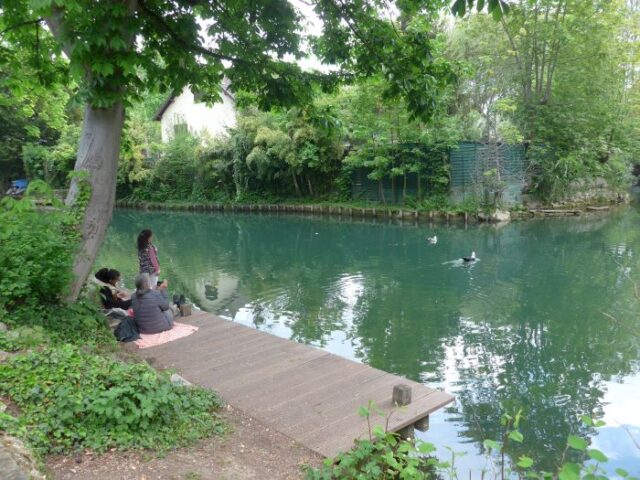
Chemin du Bras du Chapitre © Annabel Simms
Continue along the Chemin du Bras du Chapitre, passing under another footbridge, until you reach a stone road bridge. Follow the GR signs up the little street to the right which will lead you to the Rue du Moulin Berson. Turn right to continue over the bridge onto the Ile Sainte Catherine.
Cross the Avenue des Peupliers and take the Passerelle de la Pie, the long footbridge which links the Ile Sainte Catherine to St Maur on the other side of the Marne. It is worth following it for a little way to look down onto the children’s playground in the park on your right and for the spacious views of the Marne. I can recommend the children’s playhouse as the best place to picnic in if it is raining, as it is the only public shelter on the islands.
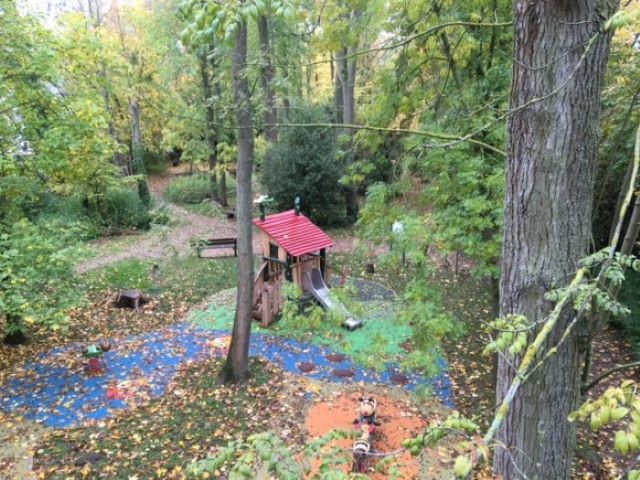
Children’s playhouse in the Parc des Ravageurs seen from the Passerelle de la Pie © Annabel Simms
Retrace your steps and turn left into the Impasse du Moulin Berson. An inconspicuous gate a few steps further along on the left leads to a smaller footbridge to the little park on the Ile des Ravageurs. Past the two picnic tables on the right there is an opening in the foliage on the left leading to a pontoon grandly called the Port de Créteil, with some barges moored alongside, and a bench. In spring tulips and daffodils flower among the bluebells and daisies and there is a water tap near the wooden tables, making the park an ideal place to stop for a picnic.
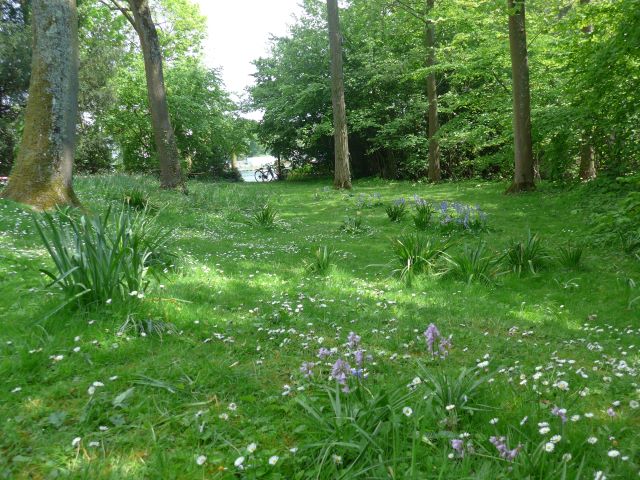
Path to the Port de Créteil, Parc des Ravageurs in spring © Annabel Simms
If the picnic tables are occupied, there is an excellent and secluded view over the Marne to St Maur from the bench at the pontoon, not to mention close-up views of the ducks.
Leave the park by the footbridge and turn right to follow the Avenue des Peupliers through the centre of the Ile Sainte Catherine. The walk takes you past secluded houses, each of which is built in a different style, from 1960s modern to traditional French rustic. The river can occasionally be glimpsed through the trees.
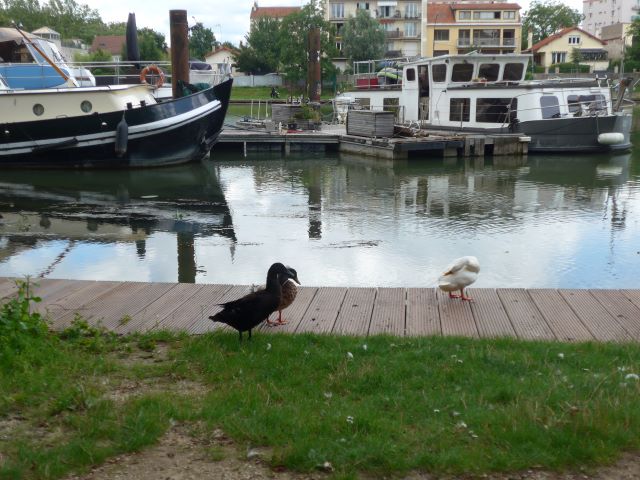
Port de Créteil, Parc des Ravageurs © Annabel Simms
Turn left into the Avenue des Uzelles, ignoring the footbridge it leads to, and then right into Avenue de la Ferme, a quiet road which contains some magnificent plane trees and feels as if it is in the depths of the country.
Cross onto the Ile de Brise Pain via another footbridge with a notice informing you that it used to be a toll-bridge. This is not surprising, as you really do feel you are crossing from one island to another.
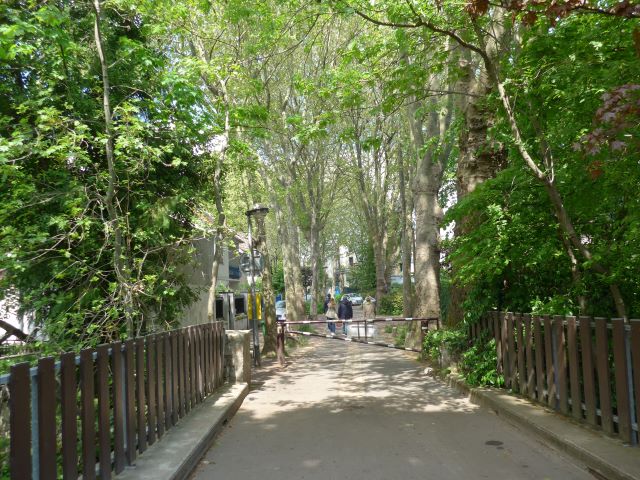
Footbridge linking the Ile Sainte Catherine to the Ile Brise-Pain © Annabel Simms
You will pass some more eccentric modern houses, including one with a huge stained glass window and the date 1976.
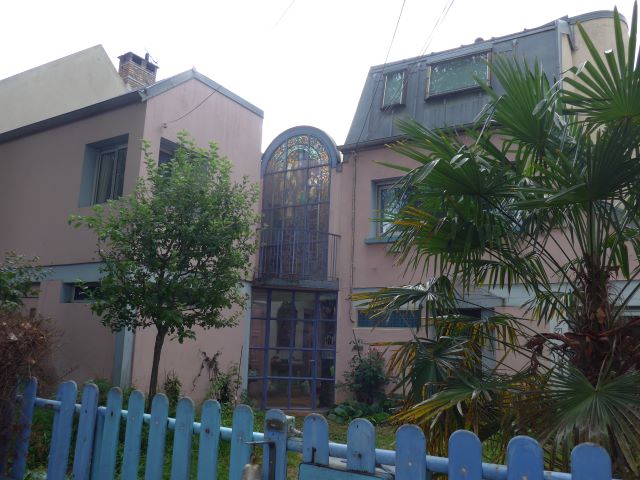
Villa, Allée Centrale, Ile Brise-Pain © Annabel Simms
Continue along the Allée Centrale to the Domaine Sainte Catherine, a 19th-century farmhouse hidden by trees which has been converted into a restaurant.
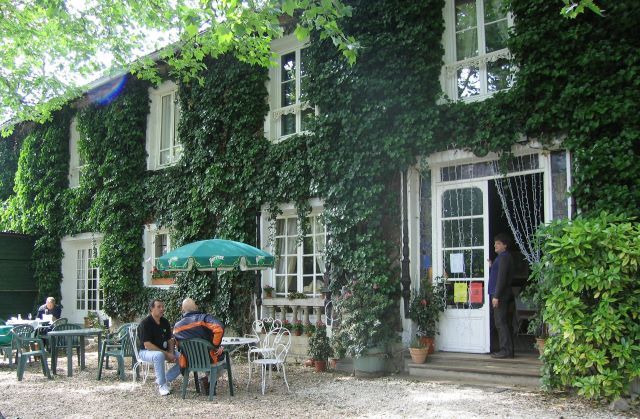
Domaine Sainte Catherine, Ile Brise-Pain © Annabel Simms
It is bigger than it looks and the shady garden overlooks the river. The menu offers traditional dishes and the leisurely ambience, with French families lingering here for hours after Sunday lunch, has not changed since I first visited it in the 1990s. It is technically closed between 3 and 7 pm, but in summer or on Sundays you could stop here just for a drink or tea in the garden if you mention this article or An Hour From Paris.
Turn right from the restaurant and continue along the Allée Centrale to the swimming pool a few steps away. Turn left just after this point, across a series of footbridges which will bring you through the Allée des Coucous to your starting point at the Chemin du Bras du Chapitre, a favorite place for animals and people to congregate.
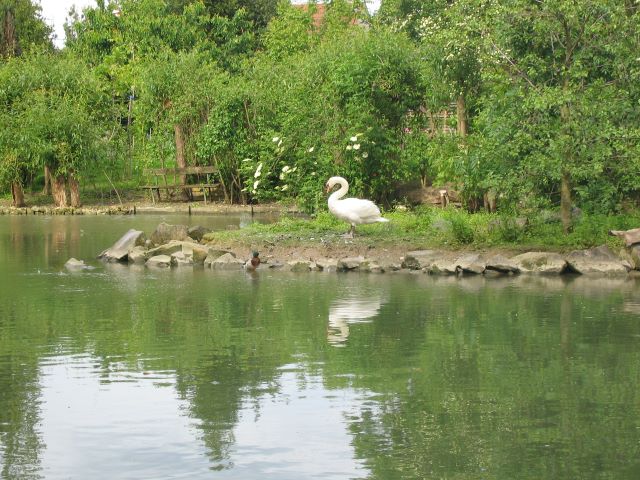
View from the central footbridge over the Bras du Chapitre © Annabel Simms
I have seen swans, ducks, herons, Barbary ducks, cormorants and a beaver-like creature called the coypu (ragondin in French), originally introduced from South America to be bred for its fur, which has happily colonized the islands. The engaging little muzzles and whiskers of these animals are sometimes visible just above the waterline. They are fed tidbits by the local children, although they do considerable damage to the river bank.
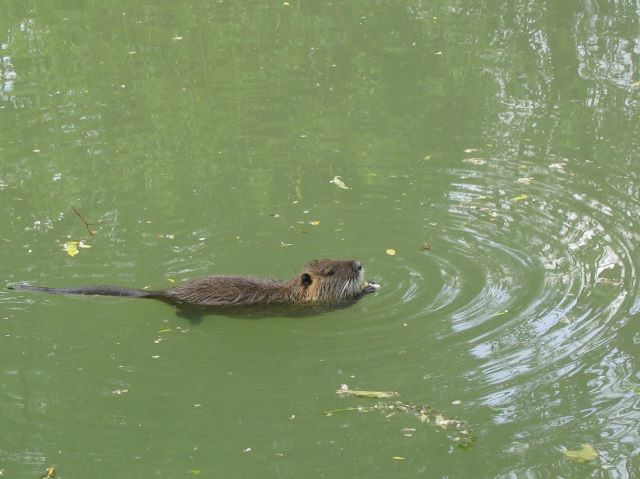
Coypu, Bras du Chapitre © Annabel Simms
Take the Chemin de Halage (towpath) to the right, past allotments (jardins ouvriers) on your left and weeping willows, swans, ducks and fishermen on your right. I have found field mushrooms here and have seen white Star of Bethlehem flowers in spring, growing close to the water’s edge.
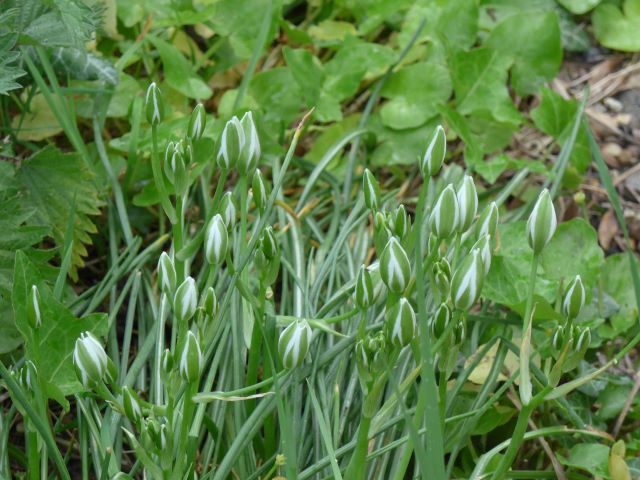
Star of Bethlehem, Chemin de Halage © Annabel Simms
At the end of the path take the steps up to the road bridge, the busy Pont de Créteil. At this point you have two options to reach the RER station at St Maur-Créteil. You could turn right to continue over the Marne and and follow the signs for Vieux St Maur to your left along the Rue du Pont de Créteil to the station in Rue Leroux on your right. This is the quickest but most traffic-heavy route to the station, just over a kilometer away.
I strongly recommend a much more rewarding 2-km walk to the station. Turn right at the top of the steps and continue to Le Plaisir du Portugal, a restaurant at the corner of the bridge and the Allée Centrale. Turn right, back into the Allée Centrale and take the first road on your left, Rue de l’Ecluse. Follow it round to the left, with a view of an enormous lock and a dam on your right.
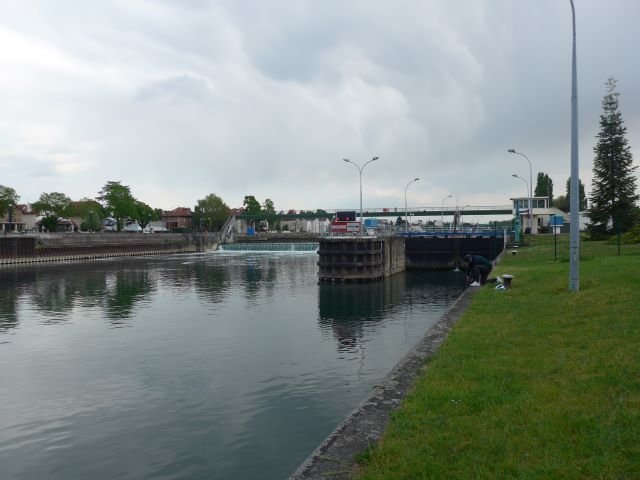
Barrage de Créteil, from the Ile de Brise-Pain © Annabel Simms
Continue under the Pont de Créteil and take the footpath straight ahead.
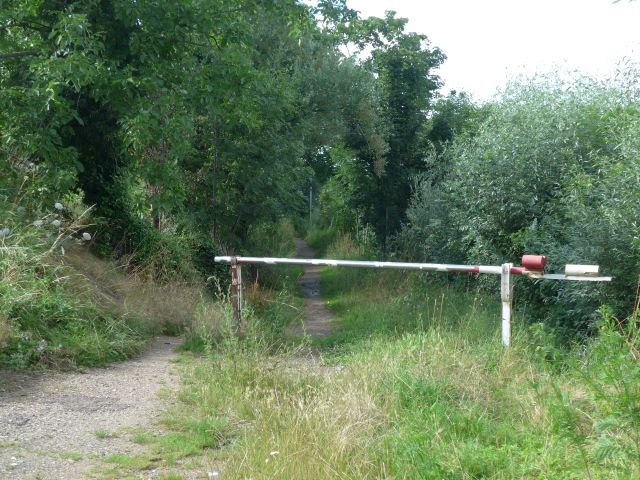
Footpath from the Rue de l’Ecluse, Ile de Brise-Pain © Annabel Simms
This part of the Ile de Brise-Pain is semi-wild, with no houses at all, although you might pass a few locals tending their allotments, children playing and some solitary fishermen. The path leads to the tip of the island where there are some wooden seats, another water tap and the residents’ allotments which have been recently established here.
The extreme tip of the Ile de Brise Pain feels like the prow of a ship, from where you have a distant view of the footbridge to which you are heading and the industrial part of St Maur across the river on your right.
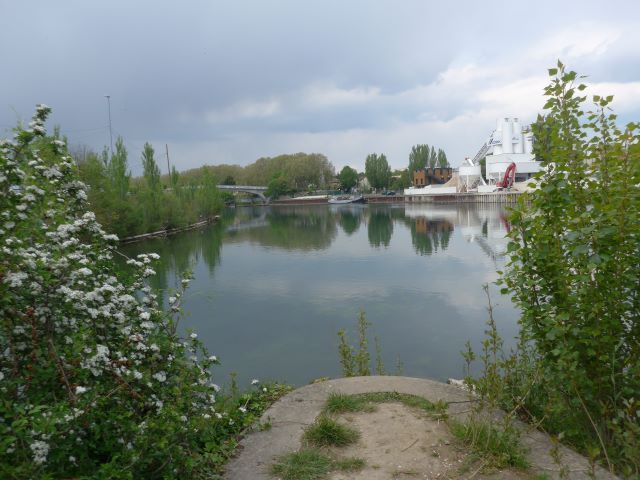
Tip of the Ile de Brise-Pain © Annabel Simms
Continue round the island, past the allotments on your left, until you reach a footpath on your right. It leads to a small but dramatic weir, favoured by fishermen.
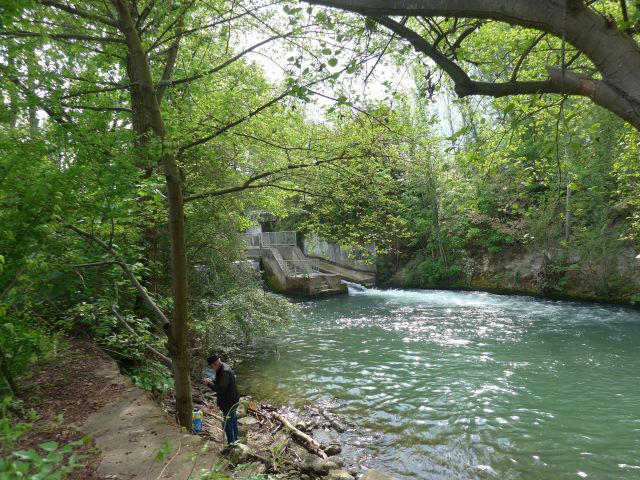
Fisherman at the weir near the Rue du Port © Annabel Simms
Take the little footbridge past the weir on your right onto the mainland and the Rue du Port. Turn right and follow the footpath along the river until you reach a bigger footbridge across the Marne, the Passerelle de Halage. En route you will pass the new métro station for Le Grand Paris which is being built in the Rue du Port, which may or may not threaten the islands’ continued charmed existence as a rural enclave.
Cross the footbridge into a quiet tree-lined road, the Boulevard du Général Ferrié, with a sushi restaurant in front of you. Turn left past the restaurant, then take the first right, the Avenue Noel, whose 19th-century houses with pretty colored tiles give it a provincial feel. This impression terminates abruptly when the road ends in the busy Rue du Pont de Créteil. Cross at the series of pedestrian crossings on the right and turn left for the Rue Leroux and the RER station at St Maur-Créteil.
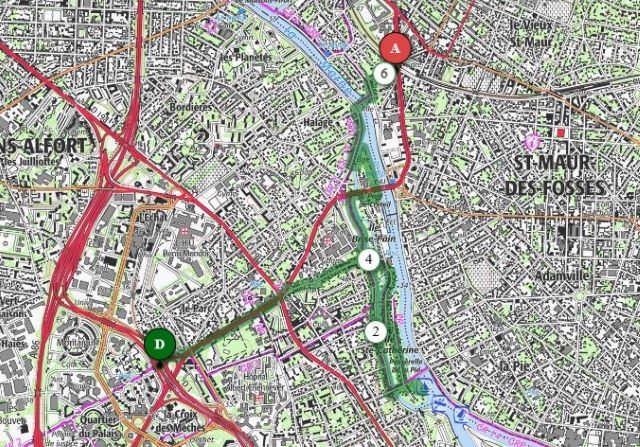
6 km walk from Créteil-Université métro to St Maur-Créteil RER © Annabel Simms
D = Depart, A = Arrive, ②= 2 km
Métro line 8 trains from Bastille leave every few minutes and take 31 minutes to Créteil-Université. Details
RER A trains from St Maur-Créteil leave every 10 minutes and take 18 minutes to Châtelet-les Halles. Details
Best map of the islands
Free app using GPS to track your route on IGN or OpenStreetMaps, IGN Rando
Annabel Simms is the author of An Hour From Paris (3rd edition 2019) and Half An Hour From Paris (2018), both available on Amazon.
Source :bonjourparis.com
